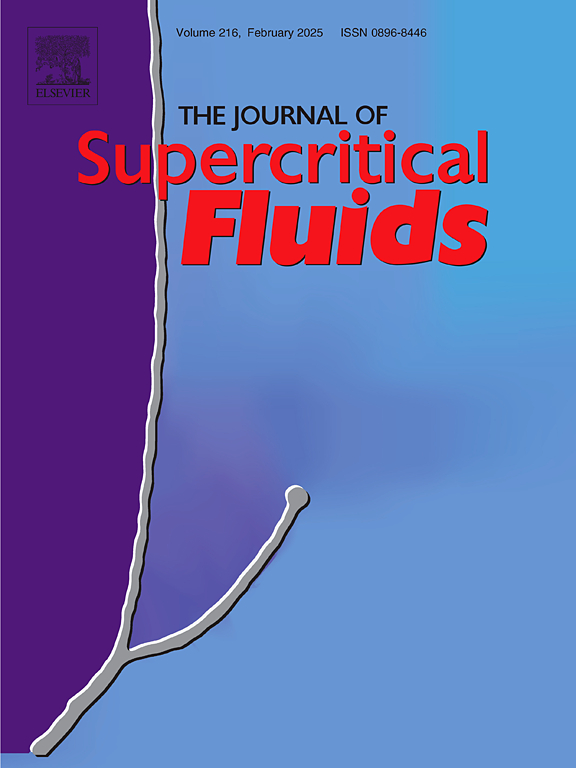Supercritical extraction of salicin, aspirin precursor, from the willow bark, laboratory optimization via response surface methodology and mathematical modeling
IF 3.4
3区 工程技术
Q2 CHEMISTRY, PHYSICAL
引用次数: 0
Abstract
In this study, salicin, the key active ingredient in willow bark and a primary source of aspirin, was extracted using supercritical CO₂. Gas chromatography (GC) characterized the extract. Key operating factors, including pressure, temperature, particle size, and extraction time, were varied to optimize extraction yield, employing response surface methodology (RSM) with a central composite design (CCD) method. The maximum yield was 12.371 % (mass of extracted salicin / mass of dry willow bark) with a 56.75 % salicin recovery under the optimal condition, determined as 22 MPa pressure, 40 °C temperature, 0.45 mm particle size, and 100 minutes extraction time. Results showed that higher extraction time and pressure increased yield, while temperature and particle size reduced it. Extraction time had the most significant effect, while temperature was the least impactful. The Sovová and Tan and Liou models were applied, showing close agreement between predicted and experimental extraction curves.
从柳树皮中超临界提取阿司匹林前体水杨苷,通过响应面法和数学建模进行实验室优化
本文以柳树皮中的主要活性成分、阿司匹林的主要原料水杨苷为研究对象,采用超临界co2法提取柳树皮中的水杨苷。气相色谱法(GC)对提取物进行了表征。采用响应面法(RSM)和中心复合设计(CCD)方法,对压力、温度、粒径和提取时间等关键操作因素进行优化,以优化提取率。最佳提取条件为压力22 MPa、温度40℃、粒径0.45 mm、提取时间100 min,提取率为12.371 %(水杨苷提取率/干柳树皮质量),水杨苷回收率为56.75 %。结果表明,较高的萃取时间和萃取压力可提高提取率,而温度和粒径则会降低提取率。提取时间的影响最显著,温度的影响最小。采用sovov模型和Tan、Liou模型,预测提取曲线与实验曲线吻合较好。
本文章由计算机程序翻译,如有差异,请以英文原文为准。
求助全文
约1分钟内获得全文
求助全文
来源期刊

Journal of Supercritical Fluids
工程技术-工程:化工
CiteScore
7.60
自引率
10.30%
发文量
236
审稿时长
56 days
期刊介绍:
The Journal of Supercritical Fluids is an international journal devoted to the fundamental and applied aspects of supercritical fluids and processes. Its aim is to provide a focused platform for academic and industrial researchers to report their findings and to have ready access to the advances in this rapidly growing field. Its coverage is multidisciplinary and includes both basic and applied topics.
Thermodynamics and phase equilibria, reaction kinetics and rate processes, thermal and transport properties, and all topics related to processing such as separations (extraction, fractionation, purification, chromatography) nucleation and impregnation are within the scope. Accounts of specific engineering applications such as those encountered in food, fuel, natural products, minerals, pharmaceuticals and polymer industries are included. Topics related to high pressure equipment design, analytical techniques, sensors, and process control methodologies are also within the scope of the journal.
 求助内容:
求助内容: 应助结果提醒方式:
应助结果提醒方式:


